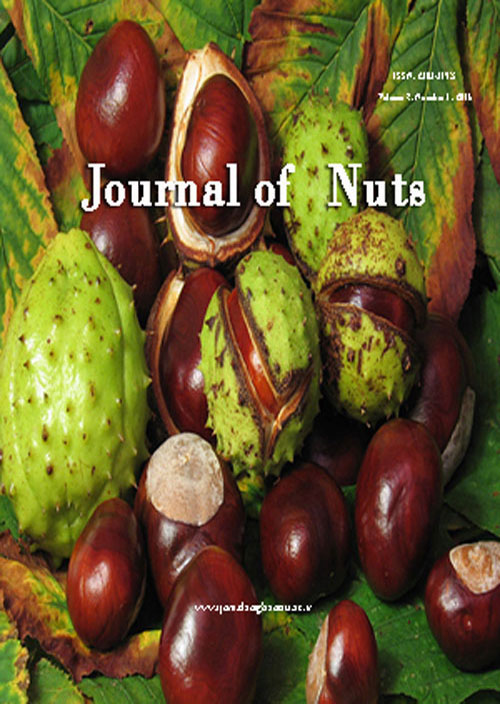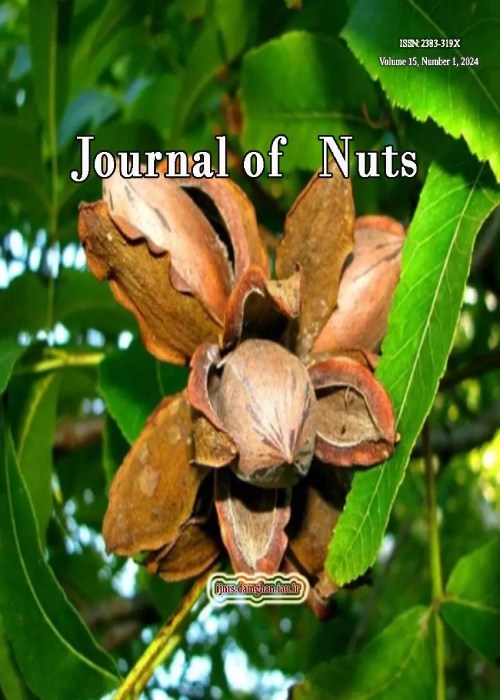فهرست مطالب

Journal of Nuts
Volume:11 Issue: 3, Summer 2020
- تاریخ انتشار: 1400/01/07
- تعداد عناوین: 6
-
-
Pages 185-193
The efficiency of conventional stratification methods for seed germination of walnut (Juglans regia L.), which uses long moist-chilling periods, is low. This experiment was conducted during winter to spring 2014 to optimize the seed germination of walnut ‘Chandler’ via changing growing media and removing seed mechanical dormancy. Fourteen treatments were tested. None of the seeds germinated without any treatment on shell or while they stored in manure. Germination percent of cracked seeds (CS) and cracked with toothpicks inserted seeds (CTS) without any stratification period reached up to 66.1% and 83.7% with mean germination time (MGT) of 0.73 and 0.98 day, respectively. Considering a 45-day cold storage period improved germination percentage of CS and CTS up to 88.3% and 94.1% with MGT of 1.02 and 1.12, respectively. Seedling growth parameters significantly increased after the cold storage period. Based on the results, mechanical dormancy was suggested as the main limiting factor for walnut seed germination. Therefore, rate and percentage of seed germination and seedling growth of walnut can be improved if the removal of mechanical dormancy is also considered in seed stratification.
Keywords: dormancy, germination, Juglans regia L, Walnut -
Pages 195-212
Bio-nanocomposite films based on sago starch containing 2% cinnamon essential oil and 3% titanium dioxide nanoparticles were used in the packaging of fresh pistachios and stored at different temperatures (4, 25, and 35 ˚C) and relative humidity (30, 50, and 70%) for 20 days, and pistachio properties were evaluated in five-day intervals. Using these films in packaging improved the physicochemical properties of pistachios, including moisture, fat, shrinkage, color characteristics, and sensory characteristics improved, and the growth of Aspergillus flavus, aflatoxin production, and the amount of hydro-peroxide increased much more slowly compared to the control samples. Temperature and relative humidity had significant effects on the physicochemical properties and deterioration of fresh pistachios (p < 0.05) as, at higher levels of temperature and relative humidity, the count of Aspergillus flavus, peroxide index, and aflatoxin had the highest values. The most desirable conditions for fresh pistachio storage were the temperature of 4˚C and 30% relative humidity. Therefore, this active packaging can be utilized as a proper alternative to conventional packaging.
Keywords: Aflatoxin, Bio-nanocomposite, Cinnamon essential oil, Pistachio, Physicochemical properties, nanoparticles, Titanium dioxide -
Pages 213-226This study was carried out to investigate the effects of foliar spray of salicylic acid and ascorbic acid on some morpho-physiological traits of Pistacia vera cv. Badami-zarand under drought stress. The experiment was conducted during 2017-2018 in the greenhouse condition, in a factorial randomized complete block design with three replications on pot plants. The soil texture of experimental pots was sandy-loam. Moreover, the three factors were considered as follows: first factor, drought stress treatments at three levels; control (100% usable moisture content), moderate stress (60% usable moisture content), and severe stress (30% usable moisture content); second factor, salicylic acid, at three levels (0, 0.5mM, and 1mM); and ascorbic acid at three levels (0, 0.5mM, and 1mM). At the end of experiment related physiological, morphological, and biochemical traits related to 6-month-old seedlings were assessed including the fresh and dry weight of leaf, stem and root, number of leaves, leaf thickness, diameter and length of stem, length of root, relative water content, rate of electrolyte leakage, rate of proline accumulation, rate of glycine betaine accumulation, chlorophyll a content, chlorophyll b content, and total chlorophyll. Generally, the results indicated that the value of morphological traits showed a significant reduction in stress treatments. In this experiment, it was found that the application of salicylic acid and ascorbic acid can also reduce the adverse effects of moderate drought stress. Furthermore, it was identified that the response of plant to salicylic acid treatment is similar to ascorbic acid. In general, the application of salicylic acid with a concentration of 0.5mM and ascorbic acid with concentrations of 0.5mM and 1mM is recommended to improve the adaptation of pistachio seedlings under moderate stress.Keywords: Badami-zarand, Drought stress, Pistacia seedling, plant growth regulators
-
Pages 227-236
Inappropriate water governance, which has been known as a variable to explain the water crisis in many parts of the world, needs to examine the institutional structures and required reforms. In the present study, the effectiveness and possibility of applying of five rural local organizations, as intermediate organizations for water resources protection in Anar and Rafsanjan areas, Kerman province, Iran, were investigated. These organizations are included as;village councils, Basij (non-governmental branch of Iranians military forces), agricultural production cooperatives, mosque board of trustees, and agricultural well curator. Here, in this research, we applied a survey method, and the research tool was two types of questionnaires which must be completed by farmers and organization managers. As the first step, the validity and reliability of questionnaires were determined. For first purpose, i.e., the determination of validity, the questionnaires were sent to a numbers of researchers, farmers, and organizations’ managers, and their received opinions were considered. For the second purpose, i.e., the determination of reliability of the questions, the Cronbach's alpha was calculated, which was about 0.83 (in a good and acceptable level). A sample of 1099 pistachio producers was selected. To measure the effects of socio-economic factors on rural local organizations efficiency, multivariate regression and the analysis of variances (ANOVA) were also applied. The final results indicated that none of these five organizations, solely, can be considered as an intermediate organization for water protection. Therefore, a formal or informal combination of the mentioned organizations might be enough efficient to improve the water resources protection factors.
Keywords: Institutional Structure, Intermediate organizations, Non-Governmental Organizations, Water crisis -
Pages 237-244
Aflatoxins are secondary metabolites produced by Aspergillus flavus, A. parasiticus, A. tamari, A. bombycis and A. nomius species. Relative humidity (RH) is one of the most important parameters influencing the development of aflatoxins in pistachio orchards by Aspergillus species. The type of irrigation system affects density and frequency of the Aspergillus species in the soil. In the current study, to evaluate fungus population density three irrigation treatments (flood, drip-surface, and subsurface irrigation) were applied. In order to investigate the population density of Aspergillus flavus in different irrigation systems, sampling was done from soil and kernels of Shahpasand cultivar at Damghan's Pistachio Research Station under various types of irrigation systems implementation. The samples were inoculated on AFPA medium using serial dilution method. The results indicated that the population density of A. flavus ranged various in pistachio kernels and soils between different types of irrigation system. Through subsurface irrigation, the population density of fungal colonies was significantly at the lowest level. The results showed that the use of modified adopted subsurface irrigation system had been effective in reducing soil surface moisture and led to decrease of population density in comparison with the conventional surface drip irrigation.
Keywords: Aflatoxin, Irrigation methods, Pistachio, Soilborne fungi -
Pages 245-256Hazelnut (Corylus avellana L.) is affected by dieback (DB) and decline (D) diseases causing significant losses to hazelnut production in the Eshkevarat (Guilan province, northern Iran) as the main region for hazelnut production in Iran. Although, causal agents of these disorders have remained uncertain for many years. During 2017-18, results of a survey on DB and D diseases in hazelnut -growing sites (HGS) from Roudsar (54 out of 199 villages) and Amlash (14 out of 124 villages) counties (Eastern Guilan) revealed that mean frequency distributions (%) of DB and D diseases based on the infected HGS in the Roudsar and Amlash counties were equal to 27.14 and 10.85%, respectively. DB and D diseases were widespread in the Eshkevarat region, where they occurred in 38.7 - 55.3% of the hazelnut orchards. Mean tree infection (%) ranged from 3.94 to 28.3% and 6.1 to 33.6% in Amlash and Roudsar counties, respectively. The fungi with different distribution frequencies included Cytospora sp. (33.60%), Phomopsis sp. (14.40%), Verticillium dahliae (11.20%), Lasiodiplodia sp. (16.80%), Rosellinia necatrix (10.40%), and Pestalotiopsis sp. (13.60%), which were isolated and identified based on their morphological and cultural characteristics and were tested for their pathogenicity. Fungal pathogens infected hazelnut trees individually, or in combinations, to cause hazelnut dieback. Most of these fungal pathogens initiate infections at wounds caused by insects, humans, machinery, lightning, wind, and hail.Keywords: Decline, Dieback, Disease management, Hazelnut, pathogenicity


